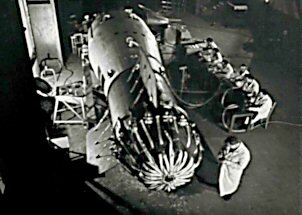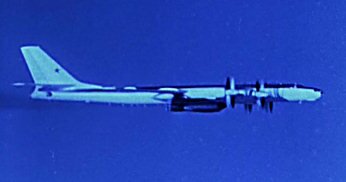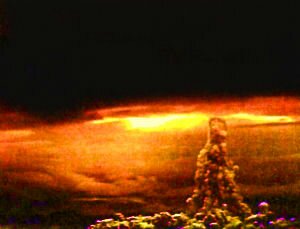
The Most Powerful Bomb Ever Constructed
 On October 30, 1961, the most powerful weapon ever constructed by mankind was exploded over the island of Novaya Zemlya in the Arctic Sea. The device was code-named "Ivan," and it was a multi-stage hydrogen bomb which was built in only fifteen weeks by engineers in the USSR, using off-the-shelf nuclear weapon components.
On October 30, 1961, the most powerful weapon ever constructed by mankind was exploded over the island of Novaya Zemlya in the Arctic Sea. The device was code-named "Ivan," and it was a multi-stage hydrogen bomb which was built in only fifteen weeks by engineers in the USSR, using off-the-shelf nuclear weapon components.
It was intended as a display of Soviet superiority during a period of grave tension between the USSR and the United States. Before Ivan, the largest explosion the world had seen was an incredible 15 megatons, an event which caused a mushroom cloud five kilometers across. Ivan’s explosion was over three times more powerful, despite the fact that the device was deliberately prevented from operating to its full potential.
The completed weapon weighed 27 metric tons, and though it was technically "aircraft-deliverable," it was too large to fit inside the bomb bay of the largest soviet bomber of that era, the Tu-95. Consequently, a Tu-95 was specially modified for the task, including the removal of the bomb bay doors to allow the bomb to protrude from the plane, and a coating of a special reflective paint to minimize the heat damage it would sustain from the fireball. Ivan was also attached to a parachute to prevent it from descending too rapidly, thereby giving the bomber adequate time to get out of range of the blast.
 Because the project had been rushed, much of the mathematical analysis was skipped, and estimations were used instead. This led to uncertainties about the system performance, and last-minute design modifications. Doubts and uncertainties notwithstanding, on October 30, 1961 the Tu-95 dropped Ivan from an altitude of 34,500 feet over the Mityushikha Bay Nuclear Testing Range at Novaya Zemlya. The weapon’s on-board barometric sensors detonated the bomb at approximately 13,000 feet at 11:32am.
Because the project had been rushed, much of the mathematical analysis was skipped, and estimations were used instead. This led to uncertainties about the system performance, and last-minute design modifications. Doubts and uncertainties notwithstanding, on October 30, 1961 the Tu-95 dropped Ivan from an altitude of 34,500 feet over the Mityushikha Bay Nuclear Testing Range at Novaya Zemlya. The weapon’s on-board barometric sensors detonated the bomb at approximately 13,000 feet at 11:32am.
Despite the cloudy weather, the flash of light was visible as far as 1,000 kilometers distant, though the sound of the blast would not reach that far for forty-nine minutes, in the form of an indistinct, heavy blow. The giant fireball reached from ground-level to about 34,000 feet into the air, violently releasing 3800 times more explosive energy than the Hiroshima bomb– equivalent to fifty million metric tons of TNT. One hundred kilometers from ground zero the heat would have inflicted third degree burns. Atmospheric focusing produced areas of destruction hundreds of kilometers from ground zero, including wooden structures which were completely destroyed, and some shattered windows in Finland. The explosion’s atmospheric shockwave traveled around the Earth three times before it dissipated.
The mushroom cloud which followed the blast was enormous in scale. It stretched sixty kilometers into the sky, and had a diameter of about forty kilometers. Ionization from the explosion disrupted radio communications for the better part of an hour.
 Some time after the explosion, a team was dispatched to ground zero to take photographs. One witness reported: "The ground surface of the island has been levelled, swept and licked so that it looks like a skating rink. The same goes for rocks. The snow has melted and their sides and edges are shiny. There is not a trace of unevenness in the ground… Everything in this area has been swept clean, scoured, melted and blown away." Analysis of the explosion showed that the area of complete destruction had a radius of twenty-five kilometers from ground zero.
Some time after the explosion, a team was dispatched to ground zero to take photographs. One witness reported: "The ground surface of the island has been levelled, swept and licked so that it looks like a skating rink. The same goes for rocks. The snow has melted and their sides and edges are shiny. There is not a trace of unevenness in the ground… Everything in this area has been swept clean, scoured, melted and blown away." Analysis of the explosion showed that the area of complete destruction had a radius of twenty-five kilometers from ground zero.
Naturally, the United States was outraged, and responded by rattling its nuclear sabre in return. The U.S. soon followed suit with an extensive series of nuclear weapons tests.
Ivan– sometimes referred to as "Tsar Bomba" or "King of Bombs"– was originally designed to yield a 100 megaton explosion, but the soviets decided that such a blast would create too great a risk of nuclear fallout, and an almost certain chance that the release plane would be unable to reach safety before detonation. Prior to testing, the engineers replaced a portion of the radioactive uranium with a lead tamper, cutting its explosive potential in half, to a "mere" 50 megatons. Later analysis showed that the fallout from a 100 megaton detonation would have resulted in lethal levels of radioactive fallout over an enormous area.
Even at half strength, Ivan was so powerful that it was completely impractical. Much of the explosion’s energy radiated upwards into space, and that which didn’t was so excessive that using the device on any populated targets world would have resulted in adverse effects on Russian interests. It served as nothing more than a show of force, and in that respect, it served its purpose well. Thankfully, no other weapon with the massive destructive power of Tsar Bomba has ever been built.











